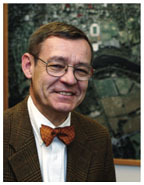
|
May 10, 2006: President's Page
THE ALUMNI WEEKLY PROVIDES THESE PAGES TO THE PRESIDENT
University Architect Jon Hlafter ’61 *63 |
Shaping Princeton’s Campus
Princeton’s campus is dotted with historic buildings and venerable trees, but as anyone who visits knows, it is also a work in progress, constantly evolving to meet the academic, residential, and extra-curricular needs of our University community. Last fall, Princeton selected the award-winning firm of Beyer Blinder Belle Architects & Planners to develop a comprehensive, flexible, and long-term master plan for our campus, ensuring that it will be at once distinctive and harmonious, as well as fully functional, in years to come. Although the campus planning process is still in its initial stages, I have asked University Architect Jon Hlafter ’61 *63 to reflect on the principles that are guiding this exciting undertaking. — S.M.T.
President Tilghman has outlined five guiding principles to be followed in planning the growth of the campus in the next decade and beyond. I would like to take this opportunity to discuss how these principles affect our thinking and planning for the future.
Maintain a pedestrian-oriented campus
One of the joys of our campus is the opportunity to discover it by walking. The ability to walk from place to place is more easily possible and desirable here than on many other campuses because most buildings are located within a 10-minute walking distance of Frist Campus Center, our common ground for students, faculty, staff, and visitors. To maintain walkability, new buildings will be located within that 10-minute walking distance wherever possible.
Preserve a park-like character
For most Princetonians, the park-like character of this campus is directly related to its open spaces. Since our efforts to maintain walkability will mean building on open spaces, we should build on less desirable open spaces (usually parking lots) while enhancing desirable green areas nearby. For example, a new 46,000-square-foot building for the Department of Operations Research and Financial Engineering has been proposed on an existing parking lot next to Mudd Manuscript Library, while new plantings will be added along the adjacent pathway, Shapiro Walk, thus enhancing the park-like character for pedestrians. In general, landscape will be used more expressively as a creative instrument. Landscape architect Michael Van Valkenburgh is developing a major tree planting program that will extend the robust natural landscapes of the southern campus farther to the north, especially along Washington Road in the vicinity of new large science buildings for chemistry, neurosciences, and psychology.
Maintain neighborhoods while promoting a sense of community
At a major university like ours, it is reasonable to expect variety and diversity both in its people and its buildings; both should be placed in environments where they can relate to each other with civility. To address that objective, architects have recently been asked to design new buildings that reinforce architectural neighborhoods. At Whitman College, for example, Demetri Porphyrios *74 *80 has designed a collegiate gothic complex intended to consolidate a traditional architectural neighborhood that extends from the corner of Nassau Street and University Place all the way to Baker Rink. On the other hand, at the Peter B. Lewis ’55 Science Library, Frank Gehry has designed a strikingly modern structure that will provide an entrance to an architectural neighborhood for today and the 21st century. It is especially crucial for the buildings in between, like the redesigned Butler College dormitories, to foster connections—both pathway connections that allow easy pedestrian movement between the two neighborhoods and stylistic connections that respect tradition on the one hand while exploring modernity on the other.
Build in an environmentally responsible manner
In planning its growth, the University has made a point of responsible energy management with the construction of a cogeneration plant and with subsequent expansions of an energy-efficient central plant. Moreover, the University has been extraordinarily proactive in embracing regional water quality regulations by constructing two regional detention basins that have been treating storm water runoff for the campus and nearby community. The campus planners are now exploring the very latest techniques that use more natural, sustainable landscapes to do the same job of improving water quality in more picturesque ways.
Sustain strong community relations
Town-gown relations in Princeton (and in virtually every other university setting) are a dynamic issue because it is in the very nature of research universities to grow when fields of human knowledge grow. Community leaders are often wary of growth by tax-exempt institutions, fearing that they may place new burdens upon tax-paying citizens. In this context, it is vital that historically good relations between the University and surrounding communities be maintained. Town-gown relationships here were important from the beginning, when the College of New Jersey moved to the tiny town of Princeton in 1756 to occupy a just completed Nassau Hall. The event marked the culmination of four years of commitment by townspeople such as Nathaniel FitzRandolph, who raised funds among his neighbors and donated four and a half acres of his land, including the site on which Nassau Hall was built. When President Aaron Burr Sr. finally began classes, a chapel in Nassau Hall was opened to townspeople for prayer and worship. Town and gown celebrated together.
Today’s celebrations of community spirit on the campus, like Communiversity, are attended by larger numbers, but University efforts to maintain good relations with its neighbors must go beyond ceremony or celebration. Recent campus planning discussions with Borough Council, Township Committee, and the Princeton Regional Planning Board have launched what should be a new era of public-spirited cooperation for dealing with hard-to-solve problems involving affordable housing, parking, traffic, and public transportation.
As we celebrate 250 years of growing in this place, the University stands
ready to meet the challenges of the years ahead by applying these sound
principles for managing future growth. ![]()


